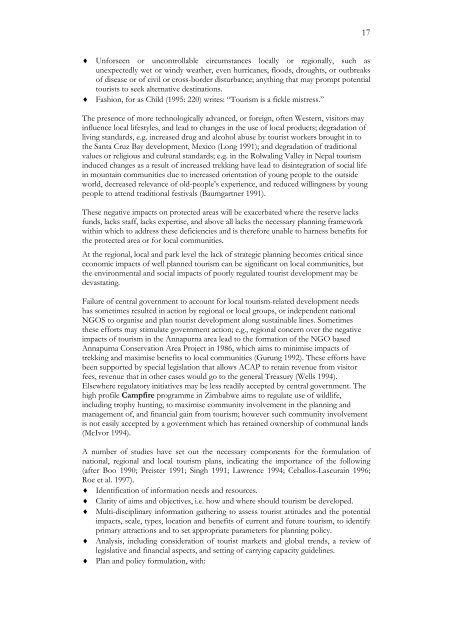The Unfenced Desert Towards a strategy for eco ... - Nwrc.gov.sa
The Unfenced Desert Towards a strategy for eco ... - Nwrc.gov.sa
The Unfenced Desert Towards a strategy for eco ... - Nwrc.gov.sa
Create successful ePaper yourself
Turn your PDF publications into a flip-book with our unique Google optimized e-Paper software.
♦ Un<strong>for</strong>seen or uncontrollable circumstances locally or regionally, such as<br />
unexpectedly wet or windy weather, even hurricanes, floods, droughts, or outbreaks<br />
of disease or of civil or cross-border disturbance; anything that may prompt potential<br />
tourists to seek alternative destinations.<br />
♦ Fashion, <strong>for</strong> as Child (1995: 220) writes: “Tourism is a fickle mistress.”<br />
<strong>The</strong> presence of more technologically advanced, or <strong>for</strong>eign, often Western, visitors may<br />
influence local lifestyles, and lead to changes in the use of local products; degradation of<br />
living standards, e.g. increased drug and alcohol abuse by tourist workers brought in to<br />
the Santa Cruz Bay development, Mexico (Long 1991); and degradation of traditional<br />
values or religious and cultural standards; e.g. in the Rolwaling Valley in Nepal tourism<br />
induced changes as a result of increased trekking have lead to disintegration of social life<br />
in mountain communities due to increased orientation of young people to the outside<br />
world, decreased relevance of old-people’s experience, and reduced willingness by young<br />
people to attend traditional festivals (Baumgartner 1991).<br />
<strong>The</strong>se negative impacts on protected areas will be exacerbated where the reserve lacks<br />
funds, lacks staff, lacks expertise, and above all lacks the neces<strong>sa</strong>ry planning framework<br />
within which to address these deficiencies and is there<strong>for</strong>e unable to harness benefits <strong>for</strong><br />
the protected area or <strong>for</strong> local communities.<br />
At the regional, local and park level the lack of strategic planning b<strong>eco</strong>mes critical since<br />
<strong>eco</strong>nomic impacts of well planned tourism can be significant on local communities, but<br />
the environmental and social impacts of poorly regulated tourist development may be<br />
devastating.<br />
Failure of central <strong>gov</strong>ernment to account <strong>for</strong> local tourism-related development needs<br />
has sometimes resulted in action by regional or local groups, or independent national<br />
NGOS to organise and plan tourist development along sustainable lines. Sometimes<br />
these ef<strong>for</strong>ts may stimulate <strong>gov</strong>ernment action; e.g., regional concern over the negative<br />
impacts of tourism in the Annapurna area lead to the <strong>for</strong>mation of the NGO based<br />
Annapurna Conservation Area Project in 1986, which aims to minimise impacts of<br />
trekking and maximise benefits to local communities (Gurung 1992). <strong>The</strong>se ef<strong>for</strong>ts have<br />
been supported by special legislation that allows ACAP to retain revenue from visitor<br />
fees, revenue that in other cases would go to the general Treasury (Wells 1994).<br />
Elsewhere regulatory initiatives may be less readily accepted by central <strong>gov</strong>ernment. <strong>The</strong><br />
high profile Campfire programme in Zimbabwe aims to regulate use of wildlife,<br />
including trophy hunting, to maximise community involvement in the planning and<br />
management of, and financial gain from tourism; however such community involvement<br />
is not easily accepted by a <strong>gov</strong>ernment which has retained ownership of communal lands<br />
(McIvor 1994).<br />
A number of studies have set out the neces<strong>sa</strong>ry components <strong>for</strong> the <strong>for</strong>mulation of<br />
national, regional and local tourism plans, indicating the importance of the following<br />
(after Boo 1990; Preister 1991; Singh 1991; Lawrence 1994; Ceballos-Lascurain 1996;<br />
Roe et al. 1997).<br />
♦ Identification of in<strong>for</strong>mation needs and resources.<br />
♦ Clarity of aims and objectives, i.e. how and where should tourism be developed.<br />
♦ Multi-disciplinary in<strong>for</strong>mation gathering to assess tourist attitudes and the potential<br />
impacts, scale, types, location and benefits of current and future tourism, to identify<br />
primary attractions and to set appropriate parameters <strong>for</strong> planning policy.<br />
♦ Analysis, including consideration of tourist markets and global trends, a review of<br />
legislative and financial aspects, and setting of carrying capacity guidelines.<br />
♦ Plan and policy <strong>for</strong>mulation, with:<br />
17

















